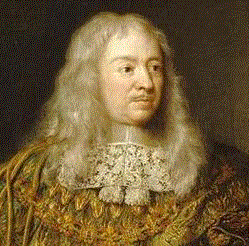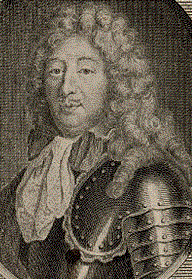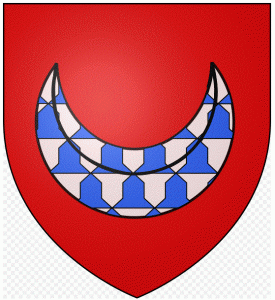The noble “De Maure” or “Demaure” family come from Ille-et-Vilaine, Brittany, France, and are descendants of noble “Anast” family.
The noble “De Maure” family come from the commune of Maure (renamed Maure-de-Bretagne in 1928) in Maure-de-Bretagne, Ille-et-Vilaine, however the commune is not named after them (in fact, it is likely that they took their surname from the Abbey of Saint-Maure in the commune. The commune was originally called Anast, after a branch of their ancestors, but was later renamed Maure after the Abbey).
The De Maure’s owned Landal Castle in Ille-et-Vilaine from 1551-1643. In 1553 Francois De Maure established the “County of Maure” in Ille-et-Vilaine (the county included the towns of Maure, Brieux, Plessix-Anger, and Londeac). The De Maure’s were lords of the area (“Counts of Maure”) until the county was sold in 1701.
Jean I de Maure, knight, and lord of Maure, was alive in 1240. Jean Maure is mentioned as serving the Duke of Brittany (Jean I le Roux) in 1241 (see note 55 on this webpage).
> Jean II de Maure,
Jean II de Maure married Raymonde de Bonaban in 1270. Château de Bonaban (Bonaban Castle) is located in La Gouesnière, Ille-et-Vilaine, Brittany. It was one of a number of castles owned by the “House of Rougé” (a noble family from Rougé, Brittany). The couple had at least two children, Jean III (born I 1275) and Robert.
Note: In 1294, a “Monsour Jehan de Maure” (“Jehan” is Old French for “Jean”) is noted as one of the three lords of Maure, Brittany (along with Monsours Geffroy and Guillaume of Anast). Each had a one-third ownership of Maure, and all three were knights. (Source: Histoire généalogique de plusieurs maisons de Bretagne, 631)
Jean II was a seneschal (“seneschal”) or steward – and knight – to the Duke of Brittany (Jean II de Dreux) (see note 85 on this webpage). Took part in the war in Flanders, in 1298 . His seal (coat of arms) was “De gueules au croissant de vair” (see the picture to the right). According to Wikipedia, a Seneschal was “an officer in the houses of important nobles in the Middle Ages… in charge of domestic arrangements and the administration of servants.”
Jean II died in 1306 (after his wife & one of their son’s, Robert) and was buried in the Abbey of Paimpont, Ille-et-Vilaine. Their other son, Jean III de Maure, survived them.
>> Jean III de Maure, Lord of Maure, b. c 1275, married Hilarie Mareil. Died in 1332.
>>> Jean IV de Maure, b. c 1305, d. 1385. Married (1) Aliette de Rochefort (of Quéhillac) in Rennes, Ille-et-Vilaine, Brittany, France (and had daughter Amicie); married (2) Marquise de Fresnay (and had son Guilaume). His children were (1) Amicie de Maure, d. c 1397; and (2) Guillaume de Maure. He was buried in Frères Prêcheurs in Nantes. In 1338 the will of Jean de Maure states that he gives his wife Marguerite de Fresnay everything he owns in the parish of Lieuron.
>>>> Jean V de Maure (1314-1385), a knight of “merit, great value, and reputation” married (1) Marquise du Pont in 1330; and (2) Plésou de la Roncière. His children included Jean VI de Maure (first born, but childless); and Guillaume VI (who married Roberta de la Haye). Guillaume’s son, Pierre I de Maure, inherited the estate of his childless uncle (Jean VI de Maure).
Jean VI de Maure was a knight who fought on the side of Charles de Blois in the Breton War of Succession (1341-1364), a war between the houses of Blois and Montfort. In this war, Charles de Blois (with the support of the French King) and Jean IV of Montfort (with the support of the English) disputed each other’s claim to be Duke of Brittany.
In 1347 Charles de Blois was taken prisoner by the English. In 1352, Jean de Maure, the “Lord of Maure”, was sent to England with several other Breton lords, to try to get him ransomed, however it would be another four year (1356) before Charles was successfully ransomed and released (with a ransom of about half a million ecús).
In 1364 the “valiant knight” Jean de Maure was taken prisoner at the battle of Auray in 1364 by a gentleman named Guezenec Kaërminiguy (Mr Kaërminiguy did not know which party Jean de Maure belonged to).This was very unusual, as it was a bloody battle and both sides had given orders to not take any captives. More than a quarter of the 4,000 French soldiers were killed in this battle, including Charles de Blois.
Following the French military loss at the battle of Auray, the first treaty of Guérande was signed in 1375, ending the Breton War of Succession and establishing Montfort as Duke. A second treaty was signed in 1381.
On 29/05/1371 Jean de Maure is described as a “gentleman” in an act; and on 10/04/1381, when he was among the lords that ratified the second Treaty of Guerande, he is described with the titles “Sir de Maure” and “Knight.” (Sources (1) The Paz; and (2) The History of Britain by Dom Morice). The first treaty of Guérande, signed April 12, 1365 ended the Breton War of Succession.
>>>>> Pierre I – married Jeanne de Fontenay in 1410, and died in 1417. Pierre inherited the estate of his childless uncle (Jean VI de Maure).
>>>>> Pierre II de Maure, Lord (Seigneur) of Maure, 1411-1465 (his son is Jean VII). He died in 1465 at Maure, Pyrénées-Atlantique, Aquitaine, France. Married Jeanne de la Lande in 1423 and died in 1465.
Note: in 1474 a “Pierre de Maure” was the Grand Veneur (Great Huntsman) of Brittany under King François II. The Grand Veneur took care of the king’s hunting dogs for the stag hunt.
>>>>>> Jean VII de Maure, Chamberlain to Duke Francis II of Brittany and King Charles VIII, d. 20 Jul 1500 (buried in the church of Maure). Married (1) Jeanne de La Chapelle, Duchess of Brieux (their son is Jean VIII de Maure); and (2) Jeanne du Pont. According to Wikipedia, a Chamberlain is “the officer in charge of managing the household of a sovereign or other noble figure.” In the list of feudal lords in the bishoprics of Saint-Malo and Dol in 1480 it recognises that presence of 25 nobles of Maure (Maure-de-Bretagne), including Jean VII de Maure (who earned 3000 livres in income).
>>>>>>> Jean VIII de Maure, Lord of Brieux, Maure & Plessix-Anger, d. 1529. Brieux is located in Orne, Basse-Normandie. Married (1) Marie Anger du Plessis Anger in 1491 (their son was Francois de Maure). Note: Château Du Plessis Anger, is in Lieuron, Ille-et-Vilaine, France (Lieuron was right next to the town of Maure in Ille-et-Vilaine). Jean VIII and Marie Anger were the lords in charge of Plessix-Anger was provided by Marie Anger and her husband John VIII
>>>>>>>> François de Maure, 1st Count of Maure, Lord of Bonaban, Baron of Lohéac, and Viscount of Fercé, 1497-1557. Born in Plessix-Anger. Château de Bonaban is located in La Gouesnière, Ille-et-Vilaine, Brittany. According to Wikipedia, Count is “a title in European countries for a noble of varying status, but historically deemed to convey an approximate rank intermediate between the highest and lowest titles of nobility.” He married (1) Hélène de Rohan in 1513, duchess of Landal Castle (daughter of Jean de Rohan, Lord of Landal Castle) – their son was Claude de Maure and their daughter was Jehanne de Maure; (2) Magdeleine de la Chapelle; and (3) Jacquemine Le Hidoux.
François de Maure, inherited from his ancestors the lordships of Maure, Brieux, and of Plessix-Anger. In 1550 he purchased what remained of the ancient and important barony Loheac. Then in 1553 he obtained from King Henry II patent letters uniting all these lordships under the title of “Comté de Maure” (County of Maure). The County included the castle of Maure, the farm, two water mills, a windmill, tennis courts & gardens. There is very little today of the Maure Castle which was sacked by the Duke of Mercœur and completely destroyed as a result of the wars of the League. In the 1561, a Huguenot church was built in the County of Maure, when the Lords of Maure became Protestants (the remains of the church can be seen today).
CHILDREN:
1. Jehanne De Maure, m. Jehan IV du Quellenec.
2. Francoise De Maure (second daughter); m. Jean de Guigny, Lord of Garoullaye and Boardaye & had several children incl. Jean Guigny.
In 1538 Francois’ daughter Jehanne/Jeanne de Maure married Jehan IV du Quellenec (the marriage record states she is the daughter of “Francois De Maure, Baron of Lohéac, and Viscount of Fercé”). She received 2,000 livres in dowry. Their children were Charles (b. 1548); Marie and Jeanne. Jeanne de Maure was Protestant, and lived in her mansion in Clarity with her children. She sometimes went to the Cornillé church services.
>>>>>>>>> Claude de Maure, 2nd Count of Maure, and Lord of Landal, 1518-1563. Lord of Landal Castle (Château de Landal) in Broualan, Ille-et-Vilaine, Brittany. The De Maure’s owned Landal Castle from 1551-1643. He married Françoise de Pompadour in 1554 (she was probably from Arnac-Pompadour, Corrèze). He fought valiantly in the war, and was made a knight of the order of the king.
>>>>>>>>>> Charles de Maure, Lord of Plessis-Anger, 1555-1575 (born at Tours, Indre-et-Loire, Centre, France). He married Diane d’Escars (Princess of Carency) in 1573, and was killed just two years later at the age of 19 or 20 in a duel (he was killed by Louis de Steuer of Caussade, Comte de St. Mégrin). His widow, Diane d’Escars, subsequently married the man who had killed her husband. Charles de Maure left only a daughter, Louise de Maure.
>>>>>>>>>>> Louise de Maure, Duchess of Landal, 1575-1643. She married (1) Odet de Matignon, comte de Thorigny (no children); (2) Gaspard de Rochechouart, marquis de Mortemart. Their son, Gabriel de Rochechouart, became Lord of Landal. Gabriel’s great grandson, Louis de Rochechouart, sold Landal Castle to Olivier de France in 1697.
>>>>>>>>>>>> Their second son Louis de Rochechouart (1602-1669) inherited the title “Count de Maure” for which he paid admission to the King in 1645. He married Anne Dony d’Attichy. He died, childless, in 1669, and his estate passed to his brother Gabriel de Rochechouart Duke of Mortemart (1600-1675) who married Diane de Grandseigne.  Gabriel was the first gentleman of the bedchamber of Louis XIII and governor of Paris.
Gabriel was the first gentleman of the bedchamber of Louis XIII and governor of Paris.
According to Wikipedia, Gabriel “spent most of his childhood with the Dauphin Louis, who became king at the age of eight years after the death of Henry IV. This intimacy with Louis XIII enabled him to obtain great benefits. In 1630, the king appointed him the first gentleman of his room… totally dedicated to Louis XIII, Gabriel de Rochechouart was able to skillfully lead his career at the court, unlike his brother, the Count of Maure, which fell into disgrace after rising against the death sentence of Marshal Marillac. He was made a knight of the king’s orders in 1633. In 1650, the Marquis was erected duke and peer of France, and as the first gentleman of the king’s chamber continued to share the intimacy of the new king, Louis XIV. He was appointed Governor of Paris and Ile-de-France in 1669. Thanks to its position, Gabriel who had married Diane Grandseigne in 1632, offered his children places leading to the court.”
When Gabriel died in 1675 almost all his estate in Brittany was sold to satisfy his creditors. Most of this was later redeemed by his son Louis-Victor de Rochechouart, duke of  Mortemart.
Mortemart.
>>>>>>>>>>>> > Louis-Victor de Rochechouart (married to Antoinette de Mesmes) redeemed most of the estate in Maure. The estate was then passed down to their son, Louis de Rochechouart. Louis-Victor served in the Franco-Dutch War (1672-1678).
>>>>>>>>>>>> > > Louis de Rochechouart (married Marie-Anne Colbert). Louis died in 1684, and two years later he was posthumously given the title of “Count de Maure”. Louis’ second son, Jean-Baptiste de Rochechouart, took the title of Count de Maure.
In 1690 Marie-Anne Colbert, Duchess of Mortemart, paid hommage to the king for the land in Maure. In 1701 she sold the county of Maure (and its annexes Lohéac and Plessix-Anger) to Jean Picquet (Lord of Motte & chief clerk of the Parliament of Brittany).
Jean gave the county to his daughter and son-in-law, Judith Picquet and Jean de Rosnyvinen Marque of Piré. Their son, Guillaume de Rosnyvinen, marquis de Piré, was the last Count of Maure. Guillaume married Louise Visdelou, and in 1790 renounced all his feudal rights over the county of Maure. Their son Pierre de Rosnyvinen immigrated, and France took the land and sold it in 1799.
REFERENCES:
1. InfoBretagne.com: Maure-de-Bretagne
2. “Our Royal, Titled, Noble, and Commoner Ancestors & Cousins” website
3. “Château de Landal” (Landal Castle) Wikipedia Page
4. Ancestors of David Henry Bergeron

